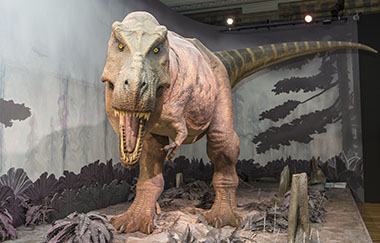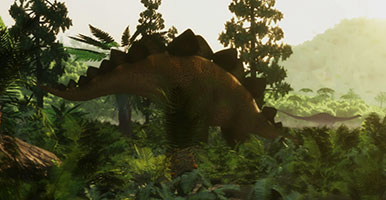A science team and palaeoartist have created a life-size Psittacosaurus model that features real colour patterns.
It has been hailed as the most scientifically accurate dinosaur reconstruction to date.
A science team and palaeoartist have created a life-size Psittacosaurus model that features real colour patterns.
It has been hailed as the most scientifically accurate dinosaur reconstruction to date.
Although rare, very occasionally evidence of pigment colour is preserved in the fossil record. Using powerful electron microscopes, scientists have been able to zoom in on impressions in the rock and observe small structures called melanosomes, which store the pigment melanin.
Dr Jackob Vinther, a palaeontologist at the University of Bristol, used the technique on 40-million-year-old fossil feathers in the Museum collection. He determined that they would have been black.
He applied the same technique to Psittacosaurus, a small plant-eating dinosaur which lived 130 million years ago during the Cretaceous Period.
With help from palaeoartist Robert Nicholls and an exquisitely preserved fossil from China, Dr Vinther was able to map the animal's colour patterns onto a life-size 3D model.
It shows that Psittacosaurus had a light underside and darker top. This colour pattern, known as countershading, is a common form of camouflage in animals today.

Meet the roaring T. rex, see the skull of a Triceratops and wander among fossils in the Dinosaurs gallery.

Find out what Museum scientists are revealing about how dinosaurs looked, lived and behaved.
Don't miss a thing
Receive email updates about our news, science, exhibitions, events, products, services and fundraising activities. We may occasionally include third-party content from our corporate partners and other museums. We will not share your personal details with these third parties. You must be over the age of 13. Privacy notice.
Follow us on social media